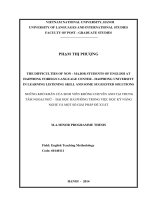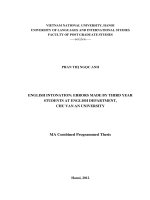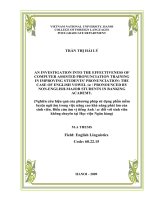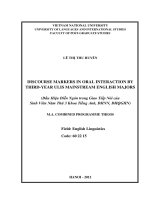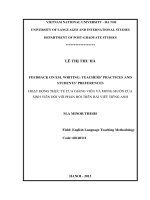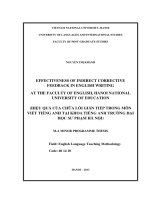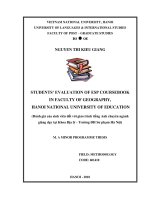Students' evaluation of ESP coursebook in Faculty of Geography, Hanoi National University of Education = Đánh giá của sinh viên đối với giáo trình tiếng Anh chu
Bạn đang xem bản rút gọn của tài liệu. Xem và tải ngay bản đầy đủ của tài liệu tại đây (169.07 KB, 5 trang )
VIETNAM NATIONAL UNIVERSITY, HANOI
UNIVERSITY OF LANGUAGES & INTERNATIONAL STUDIES
FACULTY OF POST – GRADUATE STUDIES
NGUYEN THI KIEU GIANG
STUDENTS’ EVALUATION OF ESP COURSEBOOK
IN FACULTY OF GEOGRAPHY,
HANOI NATIONAL UNIVERSITY OF EDUCATION
(Đánh giá của sinh viên đối với giáo trình tiếng Anh chuyên ngành
giảng dạy tại Khoa Địa lý - Trường ĐH Sư phạm Hà Nội)
M. A MINOR PROGRAMME THESIS
FIELD: METHODOLOGY
CODE: 601410
HANOI - 2010
VIETNAM NATIONAL UNIVERSITY, HANOI
UNIVERSITY OF LANGUAGES & INTERNATIONAL STUDIES
FACULTY OF POST – GRADUATE STUDIES
NGUYEN THI KIEU GIANG
STUDENTS’ EVALUATION OF ESP COURSEBOOK
IN FACULTY OF GEOGRAPHY,
HANOI NATIONAL UNIVERSITY OF EDUCATION
(Đánh giá của sinh viên đối với giáo trình tiếng Anh chuyên ngành
giảng dạy tại Khoa Địa lý - Trường ĐH Sư phạm Hà Nội)
M. A MINOR PROGRAMME THESIS
FIELD: METHODOLOGY
CODE: 601410
SUPERVISOR: LE VAN CANH, M.A
HANOI - 2010
ESP M.A Thesis
5
LIST OF CHARTS, FUGURES, AND TABLES
Chart 3.1: Learners’ attitude towards skill development
Chart 3.2: Learners’ attitude towards the usefulness of exercises in skill development
Chart 3.3: Learners’ fulfillment of exercises and activities
Chart 3.4: Learners’ attitude towards the necessity of an ESP course
Chart 3.5: Learners’ expectations in terms of the the time allocation for ESP course
Chart 3.6: Learners’ expectations of additional topics
Chart 3.7: Learners’ preference in terms of additional topics of the coursebook
Figure 1.1: Stages in the ESP process
Figure 1.2: The material evaluation process
Figure 1.3: A preliminary framework for materials analysis and action
Table 3.1: Learners’ ranking of their purposes of learning ESP
Table 3.2: Learners’ needs met by the ESP coursebook
Table 3.3: Learners’ attitude towards the content of the ESP coursebook
Table 3.4: Learners’ evaluation on time allocation for ESP
Table 3.5: Learners’ attitude towards vocabulary and grammar
Table 3.6: Learners’ attitude towards exercises and follow-up activities
Table 3.7: Learners’ preference for types of exercises and activities
Table 3.8: Learners’ suggestions for better coursebook
Table 3.9: Learners’ satisfaction towards classroom activities
Table 3.10: Learners’ attitude towards teacher’s use of language and the coursebook
Table 1: Teachers’ views of physical characteristics
Table 2: Teachers’ views of content
Table 3: Teachers’ perceived limitations of the coursebook
Table 4: Students’ reactions to the coursebook as observed by teachers
Table 5: Challenges to the students in using the coursebook as observed by teachers
Table 6: Teachers’ self-reported challenges in using the coursebook
ESP M.A Thesis
6
TABLE OF CONTENTS
Certificate of originality of study project report i
Acknowledgements ii
Abstract iii
List of abbreviations iv
List of charts, figures and tables v
Table of contents vi
PART I: INTRODUCTION 1
1.1. Rationale 1
1.2. Aims of the study 1
1.3. Scope of the study 2
1.4. Research questions ……………………………………………………………2
1.5. Method of the study 2
1.6. Composition of the thesis 2
PART II: DEVELOPMENT 3
CHAPTER 1: LITERATURE REVIEW 3
1.1. Approaches to ESP……………………….……………………………………….3
1.1.1. Learner-centeredness in ESP……………………………………………………3
1.1.2. Learner-centeredness vs. learning-centeredness in ESP……………………… 3
1.2. Coursebook evaluation 5
1.2.1. Definition of coursebook evaluation 5
1.2.2. Purposes of coursebook evaluation 6
1.2.3. Types of coursebook evaluation 6
1.2.4. Coursebook evaluation in ESP 8
1.2.5. Rationales of students’ evaluation 9
1.2.6. Models for evaluation 10
1.2.7. Criteria for evaluation 12
1.3. Conclusion 12
CHAPTER 2: METHODOLOGY 13
2.1. The context of the study 13
2.1.1. The course 13
2.1.2. The coursebook 13
ESP M.A Thesis
7
2.1.3. The ESP teachers 14
2.1.4. The students 14
2.2. The methodology 15
2.2.1. Participants 15
2.2.2. Data collection instruments 16
2.2.3. Procedure 17
CHAPTER 3: DATA ANALYSIS AND DISCUSSION 18
3.1. Results and discussion 18
3.1.1. Learners’ attitude towards learning ESP 18
3.1.2. Learners’ evaluation of ESP coursebook 19
3.1.3. Learners’ evaluation of the teachers’ exploitation of ESP coursebook 29
3.1.4. Learners’ evaluation of the teachers’ exploitation of ESP coursebook 31
3.1.5. Teachers’ views of ESP coursebook 33
3.2. Major findings 34
3.2.1. The suitability of the coursebook to the audiences 34
3.2.2. The suitability of the coursebook to the aims 35
3.2.3. The suitability of the coursebook to the content requirements 35
3.2.4. The suitability of the coursebook to the methodology 36
3.3. Recommendations 37
3.3.1. Content improvements 38
3.3.2. Methodology improvements 38
3.3.3. Other recommendations……………………………………………………… 39
PAER III: CONCLUSION 41
1. Conclusion 41
2. Limitations of the study 41
3. Suggestions for further researches 42
REFERENCES…………………………………………………………………… 43
APPENDIX 1 (Students questionnaire) I
APPENDIX 2 (Teachers’ views as stated in the interviews) ……………………….VI
APPENDIX 3 (A sample unit in the coursebook)………………………………….VIII

